Montreal has countless highways that, like veins of concrete, slice through the city and divide neighbourhoods. The Métropolitaine, which cuts the Saint-Michel neighbourhood in two, is one of the most visible. And yet, under this carpet of cars, another face of this neighbourhood emerges. For the past few weeks, in this place where nothing grows, an open-air gallery has taken root between d’Iberville street and Jarry street. The exhibition Sous le chapiteau (Under the marquee), initiated by the Quartier des Arts du Cirque (QUAC), invites us to look differently at the Saint-Michel neighbourhood and what this flow of concrete symbolizes. Immersion beneath the Métropolitaine.
Montreal, in the Saint-Michel neighbourhood, a Saturday around 2 pm. At Crémazie Boulevard, traffic on the Métropolitaine is smooth. Yet despite the endless stream of cars and the roar of engines, a new breath rises from the concrete. While on highway 40 cars speed past at over 70 km/h, underneath—between two uninviting arteries—another tempo takes over: the pace of slowing footsteps, the burst of colours, the echo of voices.
The Métropolitaine cuts through Saint-Michel from north to south, creating a fracture both physical and symbolic. QUAC’s executive director and the project’s initiator, Charles-Mathieu Brunelle, sets a comparison: he evokes the Berlin Wall, “the largest outdoor art gallery,” he notes. “What we’d like is to repair that fracture, but through art,” he explains. The idea is to revitalize Saint-Michel by bringing value to its territory. Where the highway once symbolized separation, there is now a collective link. Eight artistic approaches come together under the same guiding thread, aiming to bring life back to where all is grey and, in doing so, to unite the communities that make up the neighbourhood.
On about ten pillars holding up the A-40, the murals of Maliciouz, Izabelle Duguay, Bryan Beyung, Kaori Izumiya, Keithy Antoine, Marc-Alain Félix, MÏNS, and Omar transport visitors to another universe.
Beneath the concrete, a breath of life
Near the exhibition’s boutique, the final stop of the tour, we meet Maliciouz, muralist and artistic director of the project. But it’s also here, against the current, that our visit begins.
First stop: a large-scale child’s face. “That’s the daughter of Bryan Beyung, one of the artists,” says Maliciouz. She explains that he passes under the Métropolitaine daily to take her to daycare. At the base of the pillar, he painted a stamp that reads 'CPE de Saint-Michel' (Saint-Michel daycare). The artist wanted to freeze this routine in time. “His approach was awakening. Because of his daughter, he realized that daycare staff and the children, walk through here,” she continues.
.jpeg)
A bit further, giant flowers spring from the dusty ground. “Kaori Izumiya said there aren’t many flowers here,” recalls Maliciouz. Beyond revitalization, the exhibition also carries a wish to green this space, she adds.
A few metres ahead, to our right, one of Omar’s murals faces Crémazie Boulevard, a playful nod to the surrounding environment. “He wanted to extend the background we see: the cars, the road.”
Around another pillar, words take over: 'Aime-toi s’il vous plaît' (Please love yourself), 'Tu as le droit d’exister comme tu es' (You have the right to exist as you are), 'On apprend à vivre en vivant' (We learn to live by living). These phrases by Keithy Antoine rise above her drawings of a raised Black fist, and a Black woman with a radiant smile.
“It’s very joyful,” comments Maliciouz. “It’s great to have that approach, because the artists have varying degrees of expression. But when there’s a very clear message, there’s no other interpretation. It’s positive, centred on self-love. That definitely leaves a mark.”
We slow down. In this space, some columns seem to breathe. On one side, the veins of a leaf appear. This work is by Izabelle Duguay, co-artistic director of the exhibition. “Her approach is focused on micro-organisms,” Maliciouz says. You have to step closer, pay attention. “She shows life—nature—but microscopic life we’re not used to seeing.”
As we walk, the highway noise fades. A city worker is mowing the grass. He calls out to Maliciouz: “You the one who painted that?” he asks, pointing to one of the works. “Amazing! Feels good to look at!” He adds and she smiles, thanking him. This small exchange captures the essence of the exhibition: offering beauty where no one expects it.
“We’ve always thought of the underside of the A-40 in a negative way”
Under the Métropolitaine, the sound of a guitar also offers a soothing counterpoint to the highway’s chaos.
It’s Riyad Amokran, the artistic revitalization project supervisor and youth worker in Saint-Michel, who fills the space with his chords.
He grew up and still lives in the neighbourhood. For years, he passed by these anonymous pillars without really looking at them. What he saw was mostly a dark space to avoid. “It wasn’t somewhere you passed through casually. You really needed a good reason to go there,” says Amokran.
But today, he says, the revitalization is changing the neighbourhood’s mindset. In recent years, Saint-Michel has been marked by “alarming” violence. “Not only were there shootings, there were murders,” Amokran explains. Community organizations have been working to change that. For a long time, local youth didn’t trust them, which meant a real lack of participation and collective life in the neighbourhood. “In the last three years, things have gotten much better.”
The QUAC initiative, he says, also helps break old patterns. “It brings life back. You hear it in the voices of residents walking here. I’ve stopped some who told me it was the first time they’d ever decided to take a stroll in Saint-Michel. They had great feedback, they looked at every mural, every pillar—they appreciated it.”
Democratizing art and culture
“The fact that [the youth] see us here makes them want to come,” Amokran continues. And they don’t just look; they participate, and sometimes they even exhibit. “See that anti-vampire over there? That’s by Van Helsing,” he says, pointing to a piece in the exhibition boutique. Van Helsing is a young person who frequents the studio and also paints or makes music under the Métropolitaine. Others beatbox or hold dance battles.
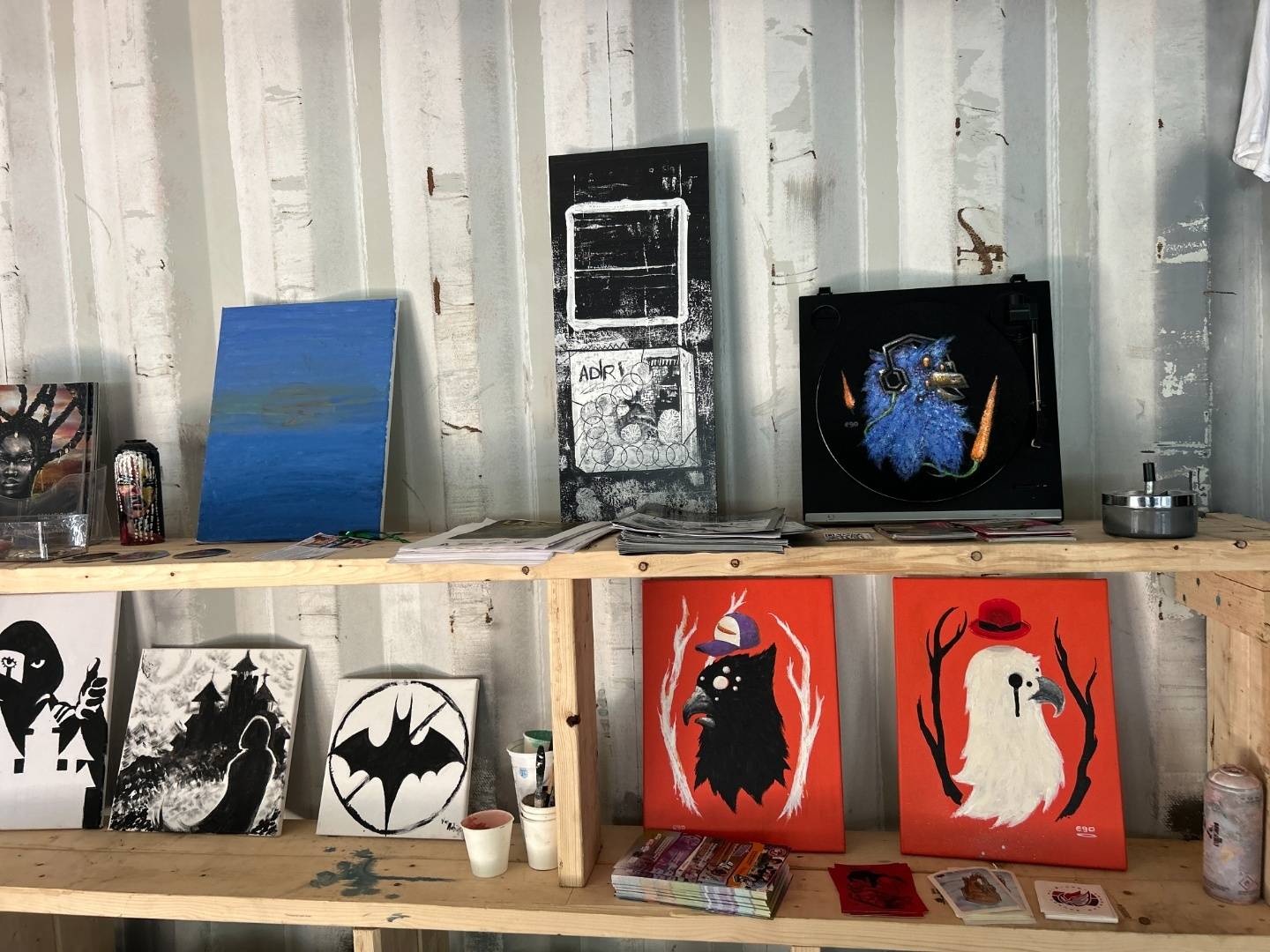
Thanks to the trust built over time, youth now dare to embrace disciplines they once thought were out of reach. “I was talking to a 17-year-old who wasn’t in school. I asked him what he thought of literature, painting… He told me: ‘That’s not for us. It’s for the bourgeois, for people in another social sphere.’” But the exhibition project, Amokran says, helps shift that perception and expand what’s possible.
That’s why he insists on the importance of democratizing access to art. The Sous le chapiteau project, led by the QUAC, works toward that goal. “It’s brought together many organizations around Saint-Michel." Even better, youth have been included in decisions from the start. “We brought young people to take part in workshops, to give their opinions,” explains Amokran.
Maliciouz: between roots and advocacy
For Maliciouz too, the A40 long represented a mental as well as physical boundary. “It felt like the neighbourhood ended there,” she says. “Just going to school in another neighbourhood, you feel like you don’t know the city you live in. Childhood, adolescence… then CEGEP, then travelling for my art. It all broadened my horizons.”
She now explores multiple dimensions in her work: spirituality, history, and especially the identity of Black people in the diaspora, particularly those who grew up in neighbourhoods like Saint-Michel. She also shows in her work both the “good” and the “bad” of the “hood.”
Her art blends symbols of Haitian Vodou culture, including sacred motifs, with urban references like bandanas, an emblem of street culture.
She knows well the street’s dual face: invisible solidarities, shared codes, but also violence, illegality, and the stigmas that cling to people. On one pillar, she painted a Black man with locks, who is pictured larger than life, in an almost mythical manner. “I wanted to portray him as a grand entity,” Maliciouz says. Far from clichés, she seeks to magnify Black men who, she says, often “have a target on their back.”

Through this project, Maliciouz reverses perspectives, offering other images, other presences rarely visible in public space. Her work is a form of repair by showing that figures carry strong and complex meaning as well as heritage.
Farther along, a mural features a fleur-de-lis, the symbol of Quebec. However, here it is tinged with ambivalence. “In Haiti’s history, the fleur-de-lis doesn’t have a positive connotation,” describes Maliciouz. In her work, the pistils of the flower become matchsticks ready to ignite. “It’s hot here for Black people in Quebec!”
Around the flower, monarch butterflies take flight, a tribute to the basketball organization Les Monarques de Montréal (The Monarchs of Montreal), which has a real impact in the neighbourhood. “It’s not just a team,” stresses Maliciouz. “The coaches are mentors and they make a real difference.”
Breaking boundaries
For Maliciouz, being an artist in Montreal often means swimming against the current. Active since 2012, she’s long had to create her own opportunities, organize her own exhibitions, and hustle non-stop. “I often proposed murals in Saint-Michel, but people didn’t want to be the first.” Property owners hesitated.
She speaks of an invisible wall between peripheral neighbourhoods and downtown, between Black artists and established galleries. Even after George Floyd, despite some openings, “there’s still a glass ceiling.” She’s also had to turn down projects when sponsors asked her to change or censor her work.
So when the QUAC leadership visited her studio at 3333, she felt something align. “This place is very symbolic for me.” Their invitation wasn’t trivial: she would open the Sous le chapiteau project as artistic director.
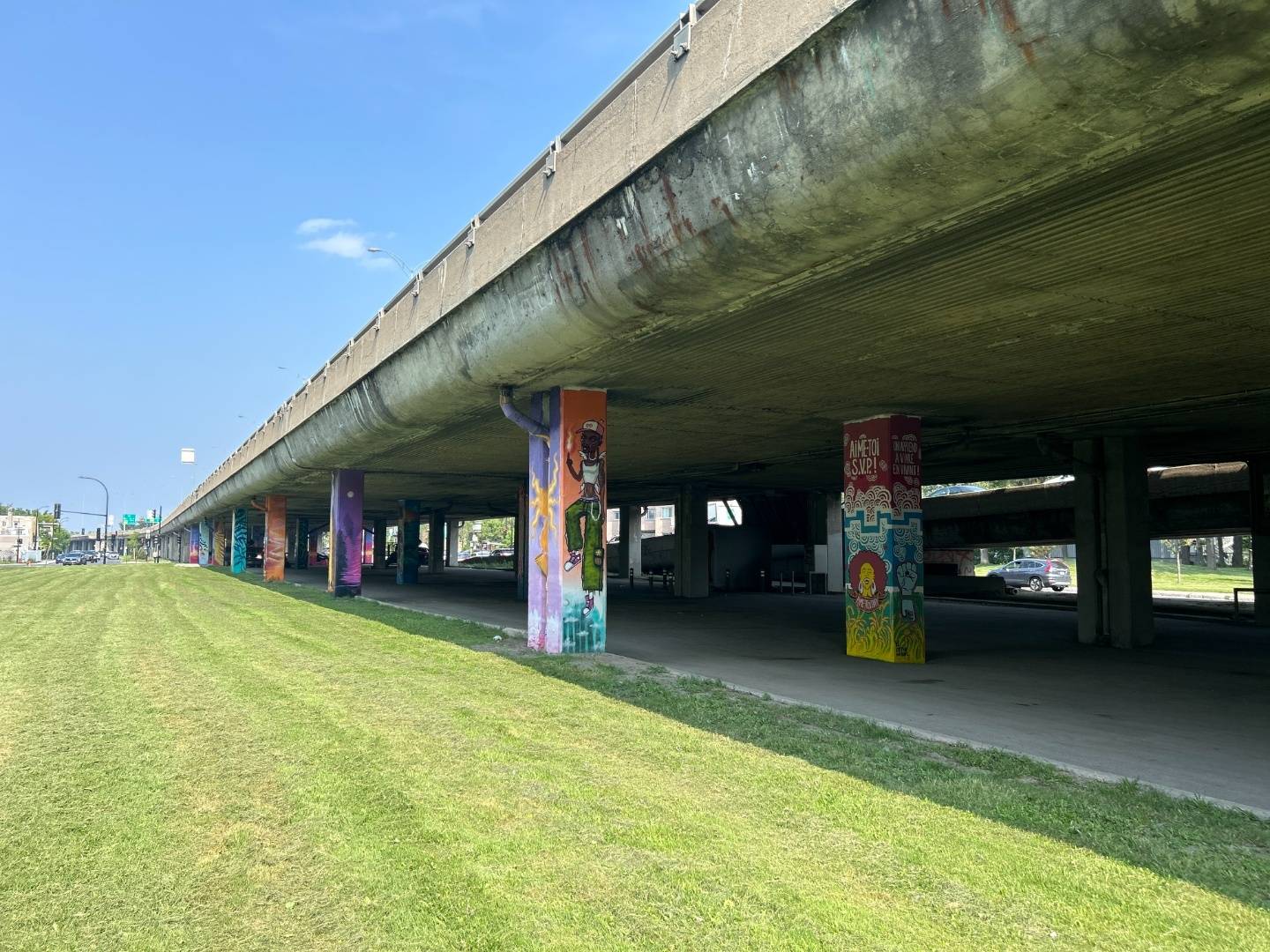
Today, her works welcome visitors at the start of the road with warm murals that create an almost magical atmosphere under the highway.
While she speaks, an impromptu scene unfolds nearby: a juggler, seeking shade, performs for passing motorists. His body in motion tells another kind of art. He’s Gonzalo Sombrerito, an artist from Chile.
For Maliciouz, as for Sombrerito, it’s not just about painting or performing. It’s about inhabiting. Bringing beauty to the in-between spaces. Weaving gestures between concrete and light that connect.
Inhabiting and revitalizing Saint-Michel
The art gallery project under the bridge is not just about beautifying. For Charles-Mathieu Brunelle, QUAC’s executive director, it’s about breathing life back into a long-neglected neighbourhood. The rebirth of a territory through art also creates jobs.
At the opening, a hundred community members showed up. Since then, he says, 20 to 30 people pass through daily to see the exhibition. And little by little, he believes, the numbers will grow.
“The idea was to slowly occupy the territory and see what happens next.” The goal is clear: to build an artists’ district—“a bit like Soho”—a “Crayola universe” that’s ecological, artistic, and job-creating for the community.
“Artists from the neighbourhood need to be able to express themselves, to tell their reality, even the horror sometimes,” Brunelle adds, acknowledging that local artists’ visibility is still too often confined to galleries elsewhere. For him, territory and culture are the two essential pillars: “The territory means eco-territory, biodiversity, ecology. And culture is human expression.”
Finally, he’s convinced that the initiative can also inspire city authorities to further support neighbourhood revitalization. “It’s the first time we’ve done something under the Métropolitaine […] There are many challenges. But little by little, we’re getting there, and I’m convinced it’s going to work.” He’s pleased that the project has gained support from multiple levels of government, including the Ministry of Transport, the borough, and the City.
The desire to expand beyond d’Iberville and Jarry is already palpable. When asked if the project should extend on both sides of the highway, the answer comes without hesitation: “Of course!” The intention is to start with the other half of the sector, to move deeper into Saint-Michel. QUAC and the artists share the ambition of transforming an entire neighbourhood, pillar by pillar, concrete block by concrete block.


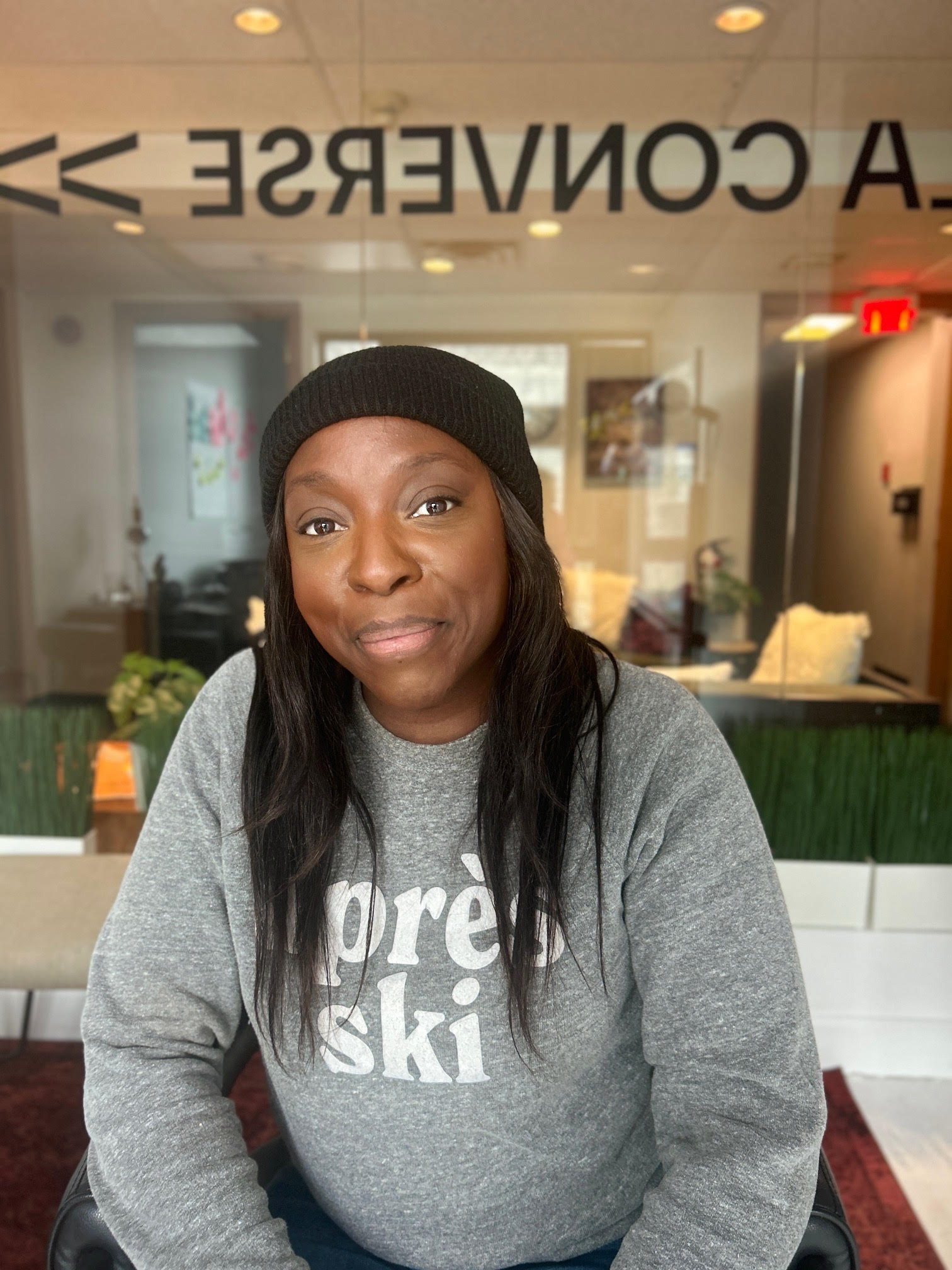

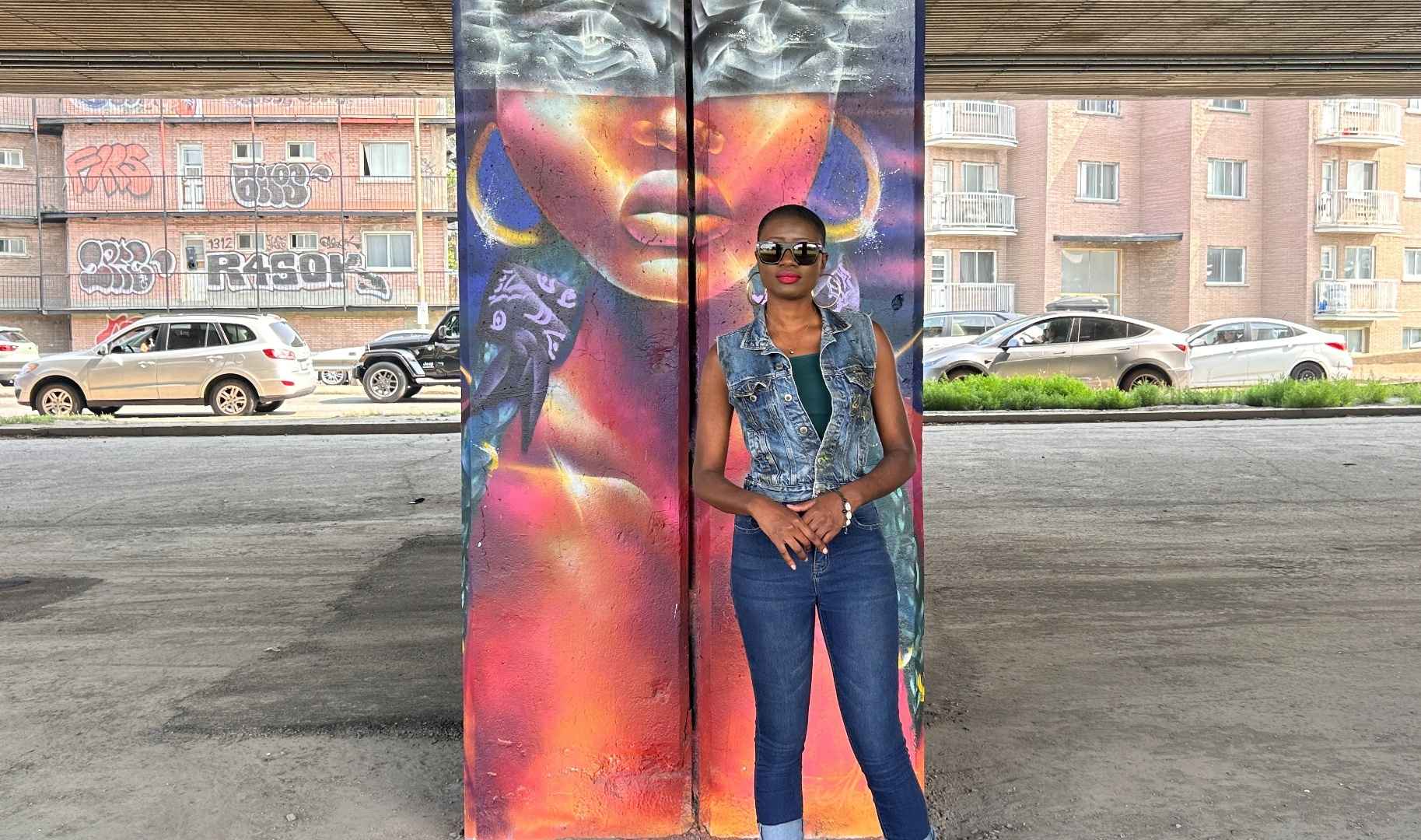
.jpg)

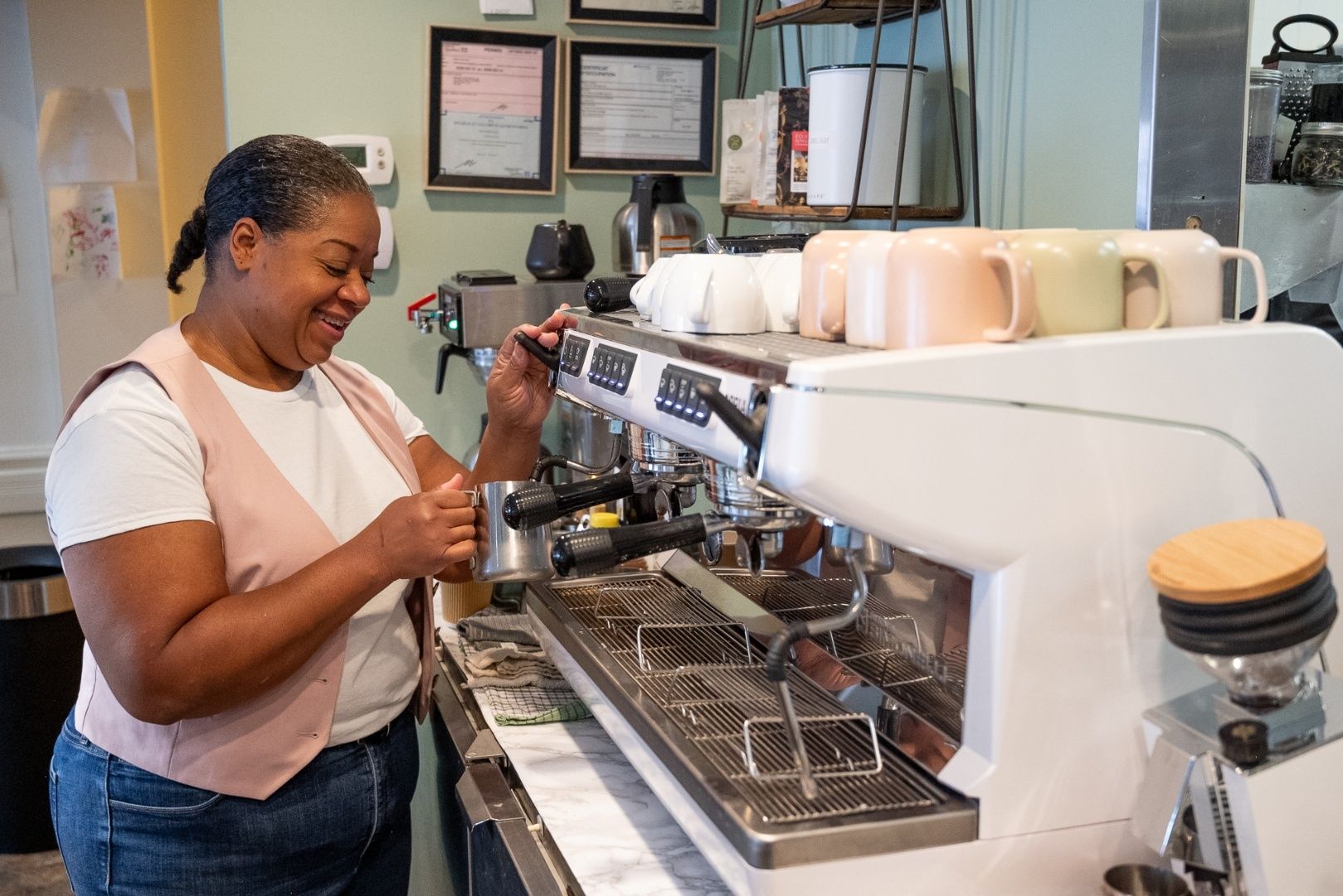
%20(1).jpg)
.jpg)
.jpg)